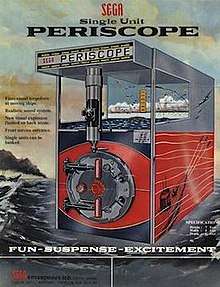Periscope (arcade game)
| Periscope | |
|---|---|
 | |
| Developer(s) |
Namco (original), Sega (international) |
| Publisher(s) |
Namco (Japan), Sega (worldwide) |
| Designer(s) | Masaya Nakamura[1] |
| Release |
Namco
|
| Genre(s) | Torpedo, Shooter |
Periscope (ペリスコープ) is an electro-mechanical shooter arcade game. It was originally developed by Namco (Nakamura Manufacturing Company) and released in Japan in 1965.[1][2] An international version was manufactured by Sega Enterprises, released in Japan in 1966 and overseas in 1967.[3]
Play
The electro-mechanical game was released in the era prior to true video games. It consists of a backdrop representing the ocean, where cardboard cutouts of ships are moved horizontally on chains. In front of this is a horizontal board with a grid of lights that represents the torpedoes moving toward the ships in side-scrolling fashion. The game is played looking through a simulated submarine periscope that limits the field of view so the horizontal and vertical playfields appear to be almost continuous. Due to the relatively large horizontal surface, and the machinery behind the vertical surface, the game cabinet is very deep, two to three times the depth of a conventional arcade game.[3][4]
Reception
The game encountered great success in Japan, and was released in the United States the following year. The game found further success in the US and in Europe.[4] The book The Rise and Fall of Sega described the game as having been "an instant hit". David Rosen later said, "If you talk to the old timers in the industry, they will tell you that The Periscope was a turning point in the industry."[3]
Legacy
In the late 1960s, Periscope revived the American arcade game industry, which had declined by 1961 due to stagnation and lack of innovation from traditional Chicago arcade manufacturers. The success of Periscope led to American distributors turning to Japan for new arcade games, which in turn encouraged competition from Chicago manufacturers, reinvigorating the industry. Sega were exporting 8 to 10 games every year in the late 1960s.[5]
In the US, it was the first arcade game to cost a USD 0.25 per play.[6] This was due to the game's high shipping cost. A quarter subsequently became the standard price for arcade games, for the next several decades.[7]
The game was cloned by Midway as Sea Raider (1969) and Sea Devil (1970). Midway later adapted it into an arcade video game, Sea Wolf (1976).[8]
The game's periscope viewer cabinet design was later adopted by several arcade video games, including Midway's Sea Wolf (1976) and Atari's Battlezone (1980). [9]
Jet Rocket
In the late 1960s, Sega developed a more advanced successor, Jet Rocket. Soon after its American release in 1970, it was cloned by three Chicago manufacturers. This negatively affected the game's performance in America, and temporarily put a halt to Sega's export business, before recovering later.[5]
Jet Rocket was a combat flight-simulator featuring cockpit controls that could move the player aircraft around a landscape displayed on a screen and shoot missiles onto targets that explode when hit.[10] It featured shooting and flight movement in a 3D environment from a first-person perspective, a precursor to first-person vehicle combat video games such as Battlezone (1980) and Hovertank 3D (1991), and the first-person shooter genre.[11]
References
- 1 2 Tweet, Onion Software
- ↑ Elemecha, Namco
- 1 2 3 Sam Pettus; David Munoz; Kevin Williams; Ivan Barroso (20 December 2013). Service Games: The Rise and Fall of SEGA: Enhanced Edition. pp. 6–. ISBN 978-1-311-08082-0.
- 1 2 Charles Hill; Gareth Jones (19 April 2011). Essentials of Strategic Management. Cengage Learning. pp. 1–. ISBN 1-111-52519-6.
- 1 2 https://archive.org/stream/NextGeneration24Dec1996/Next_Generation_24_Dec_1996#page/n10/mode/1up
- ↑ Steven L. Kent (2000), The First Quarter: A 25-Year History of Video Games, p. 83, BWD Press, ISBN 0-9704755-0-0
- ↑ Mark J. P. Wolf (2008), The video game explosion: a history from PONG to PlayStation and beyond, p. 149, ABC-CLIO, ISBN 0-313-33868-X
- ↑ http://www.pinrepair.com/arcade/sperisc.htm
- ↑ https://books.google.com/books?id=deBFx7QAwsQC&pg=PA69
- ↑ Jet Rocket at the Killer List of Videogames
- ↑ Carl Therrien, Inspecting Video Game Historiography Through Critical Lens: Etymology of the First-Person Shooter Genre, Game Studies: The International Journal of Computer Game Research, Volume 15, issue 2, December 2015, ISSN 1604-7982
External links
- Periscope on YouTube